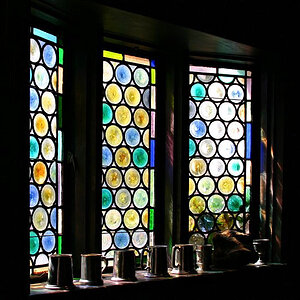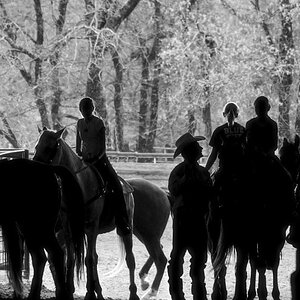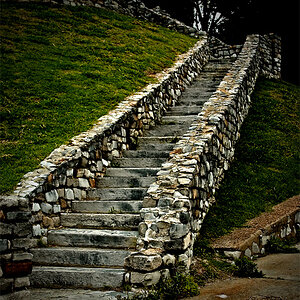TCampbell
Been spending a lot of time on here!
- Joined
- Mar 31, 2012
- Messages
- 3,614
- Reaction score
- 1,556
- Location
- Dearborn, MI
- Can others edit my Photos
- Photos OK to edit
The higher the f-stop, the greater the depth of field (there are other factors which affect depth of field besides f-stop). However... as you increase the depth of field by increasing the f-stop (decreasing the aperture diameter), you also increase diffraction. This is true of all f-stops, but it may not be noticeable. At some point, the camera becomes "diffraction limited".
This happens because light doesn't focus to a single point. Due to the wave nature of light, it focuses to a spot called the "Airy Disk" (discovered by astronomer George Airy in the 1800s). As the size of the aperture gets smaller and focal ratio increases, the size of the Airy disk increases. At low f-stops (large aperture sizes) you still have an Airy disk, but the diameter of the disk is small enough that it easily fits within the space of one "pixel" on the sensor (I'm simplifying because sensors usually have photo-sites and a combination of photo-sites make up 1 pixel.) At high f-stops (smaller aperture sizes) the Airy disk is bigger... so big that it may not fit within one pixel and will spill over onto others -- affecting their color. This has the effect of decreasing the contrast among adjacent pixels. It "softens" the image.
It's not as if the camera is fine at one f-stop and then disastrously awful at the next... it's a gradual process. The physical micron size of the photo-sites has a lot to do with this.
Is your camera diffraction limited at f/22 (image quality reduced)? The answer is yes... absolutely it is. No question. It's not a matter of camera, lens, or sensor quality... this is a physics problem and the math behind it is extremely well-understood and the physics assume the optics are "perfect".
But that's not the real question. The REAL QUESTION is... will you notice?
It turns out, when you look at an image that you took, you're not using ALL of your data.
My monitor has a resolution of 2560 x 1440 -- which is pretty high as monitors go. But that's only 3.8 megapixels. If I choose to print an 8 x 10 at 300dpi (a common print resolution) then that's only 7.2 megapixels. What's the resolution of your camera? What's the resolution of your monitor? How large are you planning to view or print? It turns out... you can afford to be fairly diffraction limited and not notice. If you want to print an 8x10 at 600dpi then you'd use 28.8 megapixels but you'd have to squint hard to see those dots at 600dpi... the human eye usually can't notice that.
If you plant to print at, say, 20 x 30" at 300dpi... NOW you're up to 54 megapixels... and now if you shoot at f/22 (and look at the print fairly close instead of from a distance) you can notice that the image is diffraction limited... but how often do you do that?
BTW - diffraction has nothing to do with chromatic aberration (aka color "fringing"). That's a completely different problem and has to do with the prismatic effect of glass. Low dispersion glass and and the complex use of different lens element configurations are designed to combat the problem by minimizing it.... but you can get fringing at any f-stop and it should be worse at low f-stops.
This happens because light doesn't focus to a single point. Due to the wave nature of light, it focuses to a spot called the "Airy Disk" (discovered by astronomer George Airy in the 1800s). As the size of the aperture gets smaller and focal ratio increases, the size of the Airy disk increases. At low f-stops (large aperture sizes) you still have an Airy disk, but the diameter of the disk is small enough that it easily fits within the space of one "pixel" on the sensor (I'm simplifying because sensors usually have photo-sites and a combination of photo-sites make up 1 pixel.) At high f-stops (smaller aperture sizes) the Airy disk is bigger... so big that it may not fit within one pixel and will spill over onto others -- affecting their color. This has the effect of decreasing the contrast among adjacent pixels. It "softens" the image.
It's not as if the camera is fine at one f-stop and then disastrously awful at the next... it's a gradual process. The physical micron size of the photo-sites has a lot to do with this.
Is your camera diffraction limited at f/22 (image quality reduced)? The answer is yes... absolutely it is. No question. It's not a matter of camera, lens, or sensor quality... this is a physics problem and the math behind it is extremely well-understood and the physics assume the optics are "perfect".
But that's not the real question. The REAL QUESTION is... will you notice?
It turns out, when you look at an image that you took, you're not using ALL of your data.
My monitor has a resolution of 2560 x 1440 -- which is pretty high as monitors go. But that's only 3.8 megapixels. If I choose to print an 8 x 10 at 300dpi (a common print resolution) then that's only 7.2 megapixels. What's the resolution of your camera? What's the resolution of your monitor? How large are you planning to view or print? It turns out... you can afford to be fairly diffraction limited and not notice. If you want to print an 8x10 at 600dpi then you'd use 28.8 megapixels but you'd have to squint hard to see those dots at 600dpi... the human eye usually can't notice that.
If you plant to print at, say, 20 x 30" at 300dpi... NOW you're up to 54 megapixels... and now if you shoot at f/22 (and look at the print fairly close instead of from a distance) you can notice that the image is diffraction limited... but how often do you do that?
BTW - diffraction has nothing to do with chromatic aberration (aka color "fringing"). That's a completely different problem and has to do with the prismatic effect of glass. Low dispersion glass and and the complex use of different lens element configurations are designed to combat the problem by minimizing it.... but you can get fringing at any f-stop and it should be worse at low f-stops.


![[No title]](/data/xfmg/thumbnail/40/40307-b3813381d3c1ef8282c72905405b50fe.jpg?1619739413)

![[No title]](/data/xfmg/thumbnail/37/37101-cf094d75976427b415711e9c9955c8a3.jpg?1619737881)



![[No title]](/data/xfmg/thumbnail/42/42230-fa8ace50a80342c7d91db1431f911bab.jpg?1619740048)




